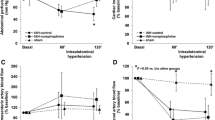Abstract
The cardiovascular response to graded PEEP ventilation (5–10 cm H2O) was studied peroperatively in patients undergoing chllecystectomy (n=8) or hepatic tumour surgery (n=3). Portal blood flow was measured by the continuous thermodilution technique and cardiac output, in a sub-group of the patients, by impedance cardiography. A parallel reduction in cardiac output and portal blood flow was demonstrated in patients undergoing cholecystectomy as the result of the application of PEEP. Thus, ventilation with 5 cm H2O of PEEP elicited a 17% decrease in cardiac output and a 26% decrease in portal blood flow. During 10 cm H2O of PEEP cardiac output decreased by 22% and portal blood flow by 32%. However, there were no significant changes in preportal tissue perfusion pressure by the application of PEEP and preportal vascular resistance increased by 22% and 30%, respectively. This indicates that a vasoconstrictor response, elicited by PEEP, in the preportal tissue is the predominating mechanism for the observed decrease in portal blood flow. Systemic oxygen transport decreased by 214 ml/min during PEEP ventilation, but preportal tissue oxygen utilization was not significantly changed due to a concurrent increase (2.9%; p<0.05) in oxygen extraction.
Similar content being viewed by others
References
Berry A (1981) Respiratory support and renal function. Anaesthesiology 55:655
Beyer J, Beckenlechner P, Messmer K (1982) The influence of PEEP ventilation on organ blood flow and peripheral oxygen delivery. Intensive Care Med 8:75
Biber B, Holm C, Winsö O, Gustavsson B (1983) Portal blood flow in man during surgery, measured by a modification of the continuous thermodilution method. Scand J Gastroenterol 18:233
Bonnet F, Richard C, Glaser P, Lafay M, Guesde R (1982) Changes in hepatic flow induced by continuous positive pressure ventilation in critically ill patients. Crit Care Med 10:703
Bredenberg CE, Paskanik A, Fromm D (1981) Portal hemodynamics in dogs during mechanical ventilation with positive endexpiratory pressure. Surgery 90:817
Bredenberg CE, Paskanik AM (1983) Relation of portal hemodynamics to cardiac output during mechanical ventilation with PEEP. Ann Surg 198:218
Bålfors E, Häggmark S, Ariola S Jr, Biber B, Pontén J, Reiz S (1983) In vitro analysis of thermal transport in coronary sinus thermodilution catheters. Clin Physiol 3:469
Dorinsky PM, Whitcomb ME (1983) The effect of PEEP on cardiac output. Chest 84:210
Dueck R (1979) PEEP and PaCO 2.Anaesthesiology 50:554
Ganz W, Tamura K, Marcus HS, Donoso R, Yoshida S, Swan HJC (1971) Measurement of coronary sinus blood flow by continuous thermodilution in man. Circulation 44:181
Haldén E, Jakobson S, Janerås L, Norlén K (1982) Effects of positive end-expiratory pressure on cardiac output distribution in the pig. Acta Anaesthesiol Scand 26:403
Hemmer M, Suter P (1969) Treatment of cardiac and renal effects of PEEP with dopamine in patients with acute respiratory failure. Anaesthesiology 50:399
Häggmark S, Biber B, Sjödin J-G, Winsö O, Gustavsson B, Reiz S (1982) The continuous thermodilution method for measuring high blood flows. Scand J Clin Lab Invest 42:315
Johnson EE, Hedley-Whyte J (1972) Continuous positive-pressure ventilation and portal flow in dogs with pulmonary edema. J Appl Physiol 33:385
Lutch JS, Murray JF (1972) Continuous positive-pressure ventilation: Effects on systemic oxygen transport and tissue oxygenation. Ann Intern Med 76:193
Manny J, Justice R, Hechtman HB (1979) Abnormalities in organ blood flow and its distribution during positive end-expiratory pressure. Surgery 85:425
Milsom I, Forssman L, Biber B, Dottori O, Sivertsson R(1983) Measurement of cardiac stroke volume during cesarean section: A comparison between impedance cardiography and the dye dilution technique. Acta Anaesthesiol Scand 27:421
Milsom I, Sivertsson R, Biber B, Olsson T (1982) Measurement of stroke volume with impedance cardiography. Clin Physiol 2:409
Owens WD, Felts JA, Spitznagel EL (1978) ASA physical status classifications: a study of consistency of ratings. Anesthesiology 49:239
Patten MT, Liebman PR, Hechtman HB (1977) Humorally mediated decreases in cardiac output associated with positive end-expiratory pressure. Microvasc Res 13:137
Pepine CJ, Mehta J, Webster WW, Nichols WW (1978) In vivo validation of a thermodilution method to determine regional left ventricular blood flow in patients with coronary disease. Circulation 58:795
Robotham JL, Cherry D, Mitzner W, Rabson JL, Lixfeld W, Bromberger-Barnea B (1983), A re-evaluation of the hemodynamic consequences of intermittent positive pressure ventilation. Crit Care Med 11:783
Schenk WG, McDonald JC, McDonald K, Drapanas T (1962) Direct measurement of hepatic blood flow in surgical patients: With related observations on hepatic flow dynamics in experimental animals. Ann Surg 156:463
Sjövall H, Redfors S, Biber B, Martner J, Winsö O (1984) Evidence for cardiac volume-receptor regulation of feline jejunal blood flow and fluid transport. Am J Physiol 246:G401
Sugimoto H, Ohashi N, Sawada Y, Yoshioka T, Sugimoto T (1984) Effects of positive end-expiratory pressure on tissue gas tensions and oxygen transport. Crit Care Med 12:661
Winsö O, Biber B, Holm C, Martner J (1983) Influence of dixyrazine on intestinal and renal vasoconstrictor responses during fentanyl-nitrous oxide anaesthesia. Acta Anaestheiol Scand 27:458
Author information
Authors and Affiliations
Rights and permissions
About this article
Cite this article
Winsö, O., Biber, B., Gustavsson, B. et al. Portal blood flow in man during graded positive end-expiratory pressure ventilation. Intensive Care Med 12, 80–85 (1986). https://doi.org/10.1007/BF00254516
Accepted:
Issue Date:
DOI: https://doi.org/10.1007/BF00254516




